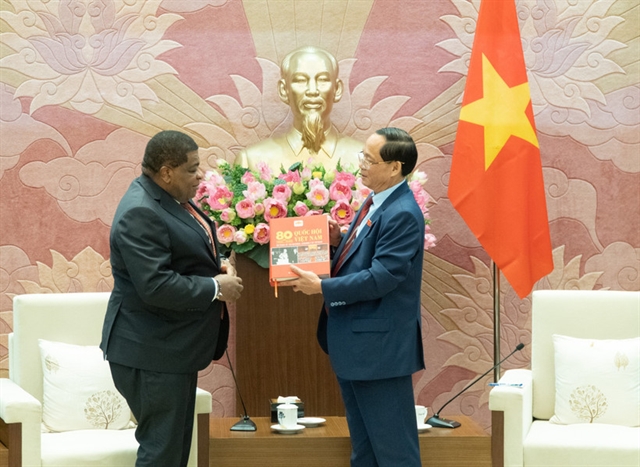 Opinion
Opinion

At the seminar "Addressing the congestion of agricultural products at border gates: what are the fundamental solutions?" held by the Government Portal, Minister of Agriculture and Rural Development Lê Minh Hoan shared his thoughts about the advantages and disadvantages facing Việt Nam's agricultural sector.

|
| Minister of Agriculture and Rural Development Lê Minh Hoan. — Photo langson.gov |
At the seminar "Addressing the congestion of agricultural products at border gates: what are the fundamental solutions?" held by the Government Portal, Minister of Agriculture and Rural Development Lê Minh Hoan shared his thoughts about the advantages and disadvantages facing Việt Nam's agricultural sector.
You once said that the congestion at the border gates happened because we have been passive? What do you mean?
Looking back at several years ago, there were also congestions at border gates, although not as serious as the situation before and after this year’s Tết holidays, which was due to the COVID-19 pandemic. When it happened, we scrambled to find the cause, asking why we depend on a large, undiversified market, why not develop the domestic market of 100 million people, why not increase the processing of goods but keep exporting raw materials, why not standardise quality, why not develop official trade, why not invest in logistics development.
But while the congestion at the border gate is happening, those questions drift away and we do not persist in finding solutions to deal with the core problems.
Farmers would rather bring their products to border gates than let them ripen on the fields. The fact that some localities warned people not to bring goods to border gates is only dealing with the problems on the surface.
Frankly speaking, the way we do agriculture is almost blind – without knowing exactly about supply and demand, without methodical cooperation and connecting between supply and demand.
In localities, farming activities are mostly unmanaged. Most localities only know how many hectares they have, not specific details about the quality of crops and certainties about markets.
Why haven’t we found out a solution for the output of agricultural products?
It’s also a story that is often forgotten just like the congestion at border gate issue. We have been happy about our export achievements, and in fact, people in the Mekong River Delta, the Central Highlands, people in key agricultural production areas, see the annual export report about agricultural products regularly sold in the Chinese market and are excited about the results.
But we do not think about the risks. This is an opportunity for both the Ministry of Agriculture and Rural Development with responsibility as the state management agency of the agricultural sector, the Ministry of Industry and Trade and the Fruit and Vegetable Industry Association to sit down and offer suggestions to implement the request of the Prime Minister: switching from unofficial quota to official quota. At the same time, there must be clear progress, consistent action from State and local management agencies and the participation of industry associations as well as enterprises exporting agricultural products through the Chinese market.
In order to change the way of exporting agricultural products from unofficial quota to official quota, it is necessary to reorganise the agriculture sector, from production to market through the logistics infrastructure system.
Another measure is to continue promoting the signing of protocols on plant quarantine of agricultural products between Việt Nam and China. How has this progressed?
We are periodically working with the Chinese, some items are not included in the protocol. China agreed that the two sides will sit down to expand more agricultural products for official export. Due to the COVID-19 pandemic, Chinese experts and officials have not been able to meet to discuss detailed action plans, but the Ministry of Agriculture and Rural Development is working with the Ministry of Industry and Trade on this matter.
In many cases, after we have been able to find a suitable market, we don’t have products that meet the standards of that market. Managing ministries and branches have the function of searching and developing the market, but localities also have to accompany by developing agricultural products that meet the standards of that market.
It is a good sign that some local authorities are working together before the time to harvest agricultural products. This is an important point to decide the fate of agricultural products in a methodical way. How should effective methods be replicated?
Recently, the Ministry of Agriculture and Rural Development and localities did two things. Firstly, on the supply side, we have an incentive programme to strengthen the identification of cultivation areas, farming areas, and processing facilities. Previously, we only develop cultivation areas after we have found a market. Now we are trying to do differently.
After we planted the crops, we can share information about expected yields on common portals or information channels for international and domestic centres, distributors, enterprises and associations so that they can actively prepare for their participation and business in the market.
We are thankful to localities, especially border-gate localities such as Lạng Sơn, Quảng Ninh, Cao Bằng, and Lào Cai. In the past, even though they were seriously affected by COVID-19, and they also had to cope with their own problems but still supported other provinces in western areas, in the Central Highlands, and the Southeast region.
And from that, we saw the need to expand the connection of the supply points in northern areas. In the future, we will gradually shift from unofficial market to official market, from exporting by road to exporting via railway, waterway and air.
It is necessary to reorganise the agriculture industry. The Ministry of Agriculture and Rural Development submitted to the Prime Minister a proposal to make Quảng Ninh Province the first centre for connecting agricultural products for export. This centre will be managed by Quảng Ninh Province and the funding will come from private sources. Lạng Sơn Province will be next.
The Chinese can send their customs clearance and quarantine units to check the goods in these centres. Then the trucks are free to run all the way to China, as far as the two sides’ traders connection allow.
If there is congestion, we can pack, preliminarily process and temporarily store goods for a while to avoid agricultural products stuck in containers for a long time. When a pandemic occurs, it is a 'green area' to prove that our agricultural products meet Chinese standards for disease prevention.
In the near future, the Ministry of Agriculture and Rural Development will draft a proposal on exporting to the Chinese market after consulting with the Vietnamese diplomatic and trade agencies in China. We will consult the Ministry of Industry and Trade, the Ministry of Foreign Affairs, and associations. We are also developing a separate scheme for the EU market.
Product quality is also a key issue. Sometimes congestion is also caused by the fact that our products do not meet the standards for export. How is our product quality filter working?
The Ministry of Agriculture and Rural Development and the Ministry of Industry and Trade regularly organise information sessions and guides for businesses. Many businesses, especially small and medium enterprises, are sometimes very ignorant on this matter. The Chinese market went from an easy-going to a demanding market a long time ago, and in fact they have informed us about this. Things did not change over a night.
It is enterprises that lead farmers in their production. If enterprises are aware of the fact that the Chinese market has become a more demanding market and that Chinese traders have changed in the way they’re looking for agricultural products, then they have to inform Vietnamese farmers.
The role of the industry associations in restructuring the agricultural sector and restructuring the market is important in the market economy because the State cannot regulate what farmers grow.
I hope that industry associations help the Ministry of Agriculture and Rural Development and the Ministry of Industry and Trade to reorganise production and reorganise the market. This is a radical solution and we must accept that we have to restructure an ecosystem, a product chain, almost from the start. — VNS




